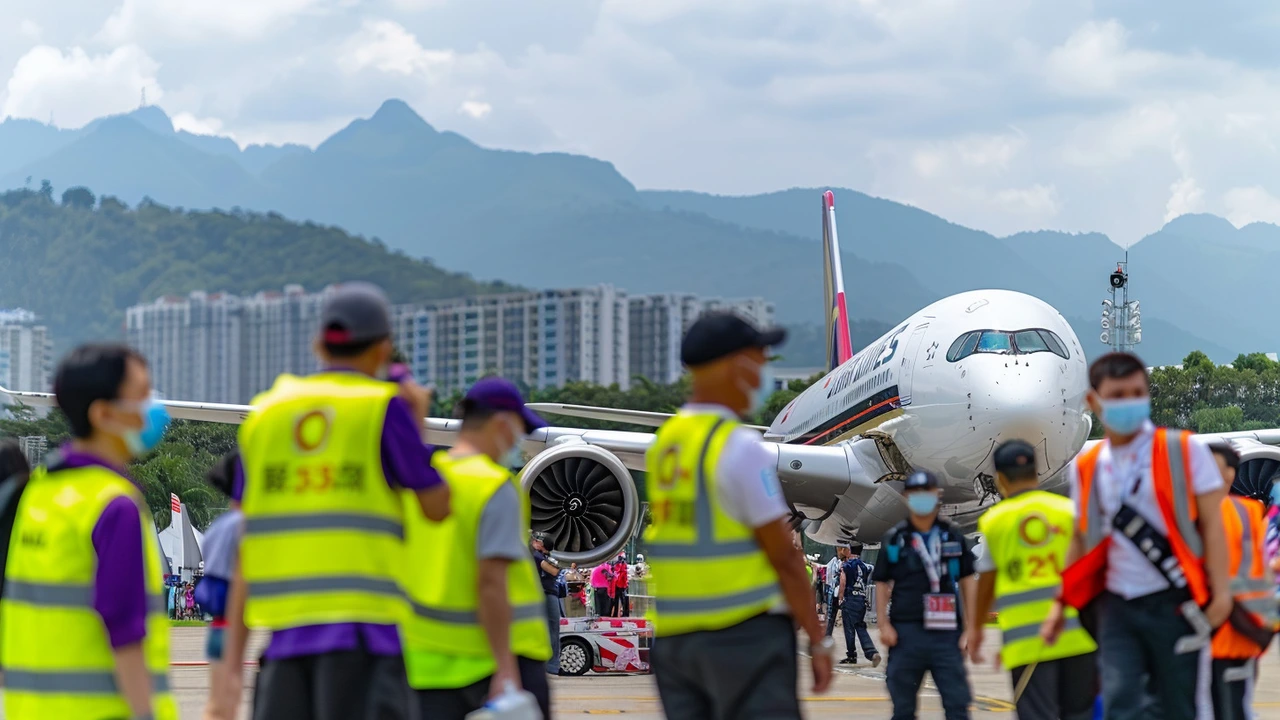Tragic Incident in the Skies: Singapore Airlines Flight Hit by Severe Turbulence
A regular day in aviation turned into a nightmare on Tuesday when Singapore Airlines flight SQ317, en route from London Heathrow to Singapore Changi Airport, encountered severe turbulence. What began as a routine long-haul journey ended in heartbreak and chaos, with one passenger losing their life and several others sustaining injuries.
The Flight: Departure and Turmoil
The airplane, an Airbus A380, departed London with 211 passengers and 18 crew members on board. All seemed normal until the aircraft reached a critical point where turbulence struck with frightening intensity. Experienced travelers know turbulence as a common occurrence, yet this was anything but ordinary. The violent shaking threw unrestrained objects and unbuckled passengers into the air, creating an immediate sense of terror within the cabin.
The Immediate Response
The pilot and crew acted swiftly and effectively to manage the situation, declaring an emergency and planning a diversion to the nearest major airport. Bangkok's Suvarnabhumi Airport was chosen for an unscheduled landing, providing a rapid response location for emergency services. The flight touched down at 3:45 p.m. local time (4:45 a.m. ET), where medical teams were ready to offer immediate aid.
The Consequences
Upon landing, the severity of the situation became apparent. One passenger was confirmed deceased, a shocking and tragic turn that had everyone aboard in disbelief. Several others required medical attention for injuries ranging from minor cuts and bruises to more serious traumas. The mood in the cabin shifted from fear to mourning and distress as those affected were attended to by professionals.
Airline and Authorities' Response
Singapore Airlines has acted promptly in the aftermath, coordinating closely with Thai authorities to facilitate medical support for the injured. A specialized team was dispatched to Bangkok to assist in the aftermath, offering on-ground support to passengers and crew. The airline released a statement acknowledging the incident and pledging full support for those impacted. They have assured that comprehensive assistance will be provided to the bereaved family and those injured.
Investigation and Moving Forward
A thorough investigation will follow to understand what precisely transpired during the flight. Analyzing the black box data, interviewing passengers, and reviewing weather conditions will be part of the comprehensive review process. While turbulence is a recognized danger in aviation, steps will be taken to understand if more could have been done to mitigate the risk and prevent this tragedy.
Passenger Reactions and Future Commitments
In the wake of the incident, passengers have shared their harrowing experiences, with many recounting the moment of terror when the turbulence hit. Their accounts will be valuable for the investigation and in informing future airline safety protocols. Singapore Airlines committed itself to transparency and continual improvements in safety measures, underscoring their dedication to passenger and crew welfare. The aviation community will closely monitor the findings and any subsequent changes in industry practices.
This tragic event on Singapore Airlines has served as a stark reminder of the unpredictable nature of air travel and the importance of rigorous safety standards and preparedness. As more information comes to light, efforts will focus on enhancing safeguards and supporting all those affected by this heart-wrenching incident.






Anita Drake
Reading about the tragic turbulence on SQ317 really hit home; it's a stark reminder of how fragile our lives can be when we take to the skies. I extend my deepest condolences to the family of the passenger who lost their life, and I hope the injured recover swiftly. Turbulence is a natural atmospheric phenomenon, yet the severity we witnessed seemed extraordinary. Modern aircraft like the A380 are built with robust safety measures, but even they can be challenged by nature's fury. Pilots undergo rigorous training to handle unexpected events, and they acted swiftly by declaring an emergency. The quick diversion to Bangkok likely saved many lives, showcasing the importance of decisive action. It also underlines the need for passengers to keep seat belts fastened whenever seated, even when the ride feels smooth. Studies have shown that a large percentage of turbulence injuries could be prevented with proper restraint. Airlines also continuously review weather data to anticipate rough patches and may adjust flight paths accordingly. I hope the forthcoming investigation uncovers any gaps in forecasting or procedural protocols. Transparency from Singapore Airlines will be crucial for restoring public trust. Supporting the victims should go beyond immediate medical care; long‑term counseling may be needed for trauma. The aviation community can use this incident to push for even stricter turbulence detection technology. Our collective empathy and solidarity can help the families cope during this painful time. Let’s also remember the crew members who managed the crisis under immense pressure; they deserve our gratitude. Finally, may this tragedy inspire further innovations that make air travel safer for everyone.
Eduardo Lopez
While I respect the crew's professionalism, it's disheartening that we continue to see such avoidable tragedies. The aviation industry should invest more in advanced turbulence prediction systems and enforce stricter seat‑belt policies. Passengers often ignore safety briefings, but the consequences are real. This incident should serve as a wake‑up call for airlines worldwide to prioritize passenger safety above all else.
Nancy Perez de Lezama
I think it’s really sad what happened on that flight. Some people say turbulence is just part of travel, but losing a life is not something to brush off. It’s important that airlines look into better ways to warn crews and passengers.
Matt Heitz
From a technical perspective, the incident underscores systemic deficiencies in predictive meteorology integration. The aircraft’s flight management system should have incorporated real‑time convective SIGMET data to pre‑emptively adjust altitude. Moreover, crew resource management protocols demand immediate dissemination of turbulence alerts to cabin personnel, ensuring seat‑belt compliance. The lack of a proactive mitigation strategy may have exacerbated the outcome.
Susan Mark
Really heartbreaking news. It’s amazing how quickly the crew got the plane on the ground in Bangkok. I hope the injured get the care they need, and that everyone’s thoughts are with the family. Safety first, always.
Jason Jennings
Yeah, great job by the pilots. Still, it's kinda scary that something like turbulence can turn deadly. Maybe airlines should just give tighter seats and more padding.
Diego Vargas
its awful when a flight turns into a nightmare. i think they could do better with warning systemz. hope every1 recovers quick.
Alex Lee
Honestly, this is why I avoid flying. One bad bump and lives are lost. Airlines need to be more responsible.
Vida Yamini
First of all, my heart goes out to everyone affected by this awful incident. It’s truly devastating when a routine trip turns into a tragedy. From a coaching standpoint, this situation highlights the importance of preparedness and mental resilience, both for the crew and passengers. When turbulence hits, staying calm can make a huge difference in how we respond. It’s also a great reminder that safety briefings aren’t just formalities; they are essential life‑saving instructions. Passengers should always keep their seatbelts fastened when seated, even if the flight feels smooth. The crew’s swift decision to divert to Bangkok showed excellent situational awareness, which should be praised. That said, airlines could invest more in advanced turbulence detection technology, which would help pilots anticipate and avoid severe conditions. Enhanced training programs that simulate extreme turbulence could also improve response times. In the meantime, we as travelers can do our part by listening to crew instructions and staying seated when advised. The emotional support for the victims and their families is crucial, and community solidarity can help them heal. Finally, let’s hope the investigation leads to concrete improvements that prevent future occurrences of this nature.
James Lawyer
In accordance with established aviation protocols, the diversion to Suvarnabhumi Airport was the appropriate corrective measure. The subsequent medical response aligns with international safety standards, thereby mitigating further risk.
Abby Culbertson
so sad. hope everyone gets better soon.
Awolumate Muhammed Abayomi
Sending positive vibes to all the injured! It's amazing how quickly the medical teams responded. Let's keep the community supportive and make sure the families know they're not alone during this tough time.
Josh Tate
It’s really distressing to read about this incident, and I feel for everyone impacted. The way the crew handled the emergency shows how critical training and teamwork are in crisis moments. I think it’s important that airlines continue to emphasize the safety briefing and encourage passengers to keep their seatbelts fastened whenever they’re seated. The psychological aftermath can be just as serious as the physical injuries, so offering counseling services should be a priority. Overall, this tragedy underscores the need for continuous improvement in both technology and human factors within aviation safety.
John Smith
Well, technically turbulence is just air moving at different speeds; pilots already have procedures for it. The real issue is passenger compliance – if everyone just kept buckled up, the injuries would have been minimal. It's a basic safety rule that seems to get ignored too often.
Alex Soete
What a terrible event! Still, I’m glad the crew acted fast and got everyone to safety. Let’s focus on supporting the survivors and learning from this to make flights even safer in the future. Together we can push for better turbulence detection and keep the skies kinder for everybody.
Cara McKinzie
Honestly, this whole thing feels like a scene straight out of a disaster movie. The drama, the panic, the heartbreak – it's all just too much. I can’t stop thinking about the poor souls who were tossed around like rag dolls. Airlines need to up their game; I’m talking bigger seatbelts, sturdier cabin interiors, maybe even airbags. If we’re going to keep traveling at 35,000 feet, we deserve to feel safe, not like we’re on a roller coaster that could snap any second.
Joseph Conlon
It was a nightmare.
Mohit Singh
These incidents highlight why airlines should be more aggressive about investing in high‑end radar and predictive models. Passengers deserve a proactive approach, not just reactive measures after a tragedy.
Damian Liszkiewicz
Sending love and strength to everyone affected 🙏. Let’s keep the conversation focused on how we can improve safety and support the families. #AviationSafety #StaySafe